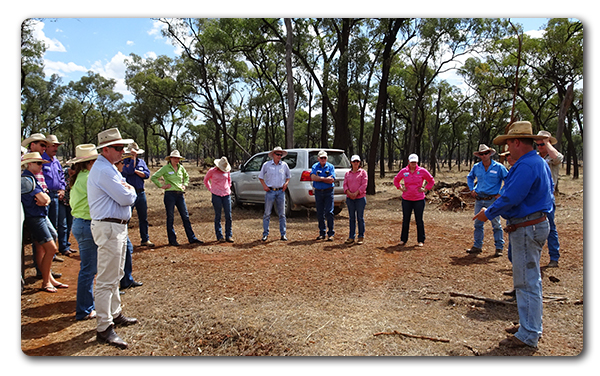Graziers take opportunity to network and learn at Clothes Peg Station
From managing animal nutrition in the dry season to adopting strategic planning tools for business development: fifteen graziers from across northern Queensland discussed some of their key challenges and successes at a recent ‘Keeping in Touch’ day at Clothes Peg Station.
Hosted by NQ Dry Tropics and Resource Consulting Services (RCS) at the Murphy family’s property 160 km north of Hughenden, the joint initiative gathered like-minded producers to network, gain confidence to improve their practices and planning tools, and help to build resilient pastures, cattle and businesses.

Helping to facilitate the event, NQ Dry Tropics Field Officer Linda Anderson said the session offered a rare opportunity to talk openly about challenges and successes that were unique to running a grazing operation in the Burdekin Dry Tropics region, with the attendees collectively managing over 200,000 hectares across eight enterprises.
“This project has a strong emphasis on building overall resilience in grazing businesses and supporting families to adopt improved practices,” Ms Anderson said.
“The networking and peer-to-peer discussion throughout the day was highly valuable to all attendees, including hosts David and Jo Murphy.”
Clothes Peg Station is one of 10 Burdekin grazing properties undertaking annual benchmarking to track business and grazing performance as practice change occurs, as a part of the three-year Saving Our Soils Burdekin project.
“We needed to be a part of the discussion again – it triggered a lot of thoughts about how we can make improvements in our business,” said Jo Murphy.
The key message graziers took from the morning session focused on the importance of dedicating time to work on overall business strategies as a family unit.
“It’s important for graziers to take a long-term approach to building their business,” James Barnet from RCS said.
“Developing and reviewing budgets that look five years into the future, rather than just serving short-term financial commitments, is critical for success.”
Graziers revealed personal stories, discussing their experiences implementing rotational movement of bigger mobs of animals through smaller paddocks, and allowing longer recovery periods for pastures. The impact of this strategy was seen first-hand on a tour of Clothes Peg, with a fence line comparison highlighting pasture quantity and composition differences in paddocks used for short-term grazing and longer term continuous grazing.
Ultimately, it was the stories shared by attendees about the successes and challenges faced in grazing in the north that struck the biggest chord. Amanda Dixon, from Bagstowe Station, reflected: “While we have already implemented most of the land management practices discussed today, it was great to have input from other graziers about what, and why, they are doing things.”
The ‘Keeping in Touch’ day was supported through the Saving Our Soils Burdekin project funded by the Australian Government Reef Trust through the Queensland Government Department of Environment and Heritage Protection.
